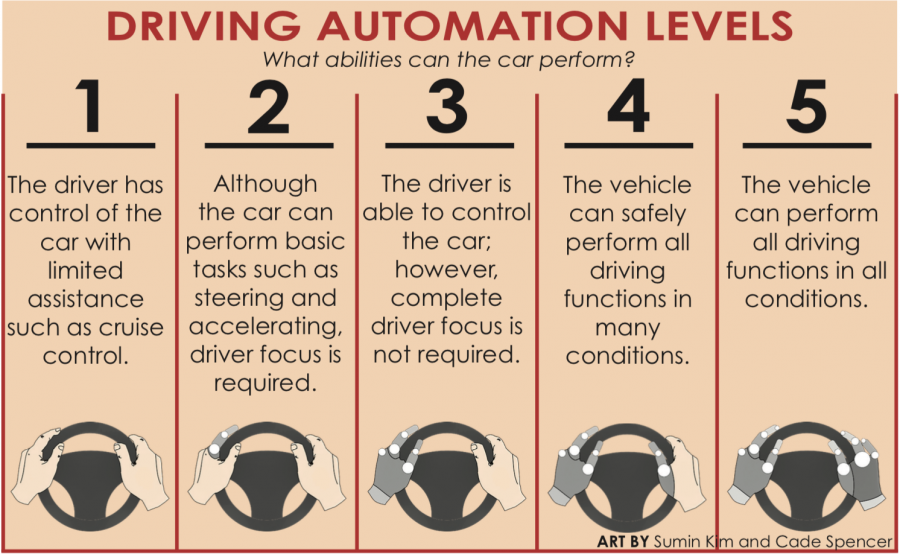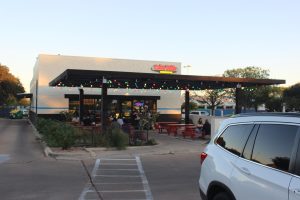Autonomous cars in Austin fuel concerns for driver safety
As we progress into a technology based age, transportation advances with us.
November 15, 2019
Austin: a city overflowing with live music, bats, and “Keep Austin Weird” stickers, can soon add self-driving cars to its growing list of unique sights.
Austin is the third city to be announced by Ford in their Autonomous 2021 plan, following Miami and Washington, D.C. In their plan, Ford has aimed to create a fully autonomous car by 2021 that will be available for commercial uses, such as ride-sharing and delivery. They are partnered with Argo AI, an artificial intelligence company specializing in autonomous vehicles.
In a statement to the public released Sept. 25, Peter Rander, President of Argo AI, described what preparations will be made in Austin, starting as soon as November of this year.
“Over the coming months, our vehicles will be manually driven through east Austin as well as downtown, mapping the city’s main corridors in preparation for autonomous testing,” Rander wrote. “Eventually we will expand beyond these areas, but these initial mapping trips help us develop a comprehensive understanding of the environment around our vehicles.”
The car created by Ford and Argo AI will register as a level four on the autonomous vehicles scale, meaning that the car will be able to drive itself in almost all situations without a driver’s assistance. No vehicles of this level have been produced for commercial use prior to this plan.
According to a statement on Ford’s website, “The vehicle will operate without a steering wheel, gas pedal or brake pedal within Geo-fenced areas as part of a ride sharing or ride hailing experience.”
It is very evident that these vehicles have the potential to change the transportation system of Austin. However, many people have opposing views on the topic of autonomous vehicles, specifically on their safety and effectiveness.
“I think self-driving vehicles are a very exciting innovation, that if used wisely and regulated carefully, could change our society and the way we travel for the better,” junior Conner Petru said.
Other students are more wary about how these cars will affect the dynamic of Austin traffic.
“I think this will impact Austin traffic negatively since [it] is already so bad,” sophomore Jessie Schafer said. “People are more irritable and don’t want to deal with any mistakes a self-driving car may make.”
There are many cars today with partially autonomous features, such as cruise control or lane assistance. These capabilities give a glimpse into what is to come with Ford’s Autonomous 2021 project, but they also do not require as much of the user’s trust as the autonomous Ford vehicles will.
“It was a very surreal experience, knowing that the car was in control,” Petru said on his personal experience in a partially autonomous car. “But at the same time, it was comforting to know that the driver could take back control at a moment’s notice to steer clear of an obstacle or abrupt change in the road.”
The lack of human control in a vehicle without a steering wheel, gas pedal, or brake pedal has raised many concerns about the vehicle’s safety, specifically how it would react in a split-second decision.
“It’s troublesome to think unempathetic machines will be driving in situations that require ethical decision making,” Petru said. “I worry that these self-driving cars would have trouble making split decisions that could injure the driver or other people.”
Other students are concerned that the cars will disrupt how normal drivers operate on Austin roads.
“I am concerned that self-driving cars will be introduced and available before they are perfected,” Schafer said. “This could make people more nervous on the roads, leading to more crashes.”
In their public statement, Ford and Argo AI addressed these concerns and expressed a desire to share their project with the Austin community in order to increase the safety of their product and the benefits it provides.
“Self-driving vehicles are a potentially transformative technology, but we understand that in order for them to be truly successful, we have to build confidence in their safety,” Rander wrote. “Working with Ford as well as city, state and federal officials, we look forward to engaging the Austin community as we aim to build a safe vehicle service that expands access to jobs, transportation and communities.”
Even when autonomous cars arrive, Schafer believes it will take time for them to reach Southwest Austin.
“I don’t think self-driving cars will affect the Bowie community very much because I don’t think many teens will get self-driving cars to drive to school,” Schafer said. “However, some Ubers that are called could be self-driving cars, causing potential chaos.”
As Ford develops the vehicles for the autonomous 2021 program, they plan to make them hybrid-electric, which would give the cars the ability to work and be rented out all day without extended charging times.
“These cars will definitely give Bowie students and staff an interesting taste of how AI might change our lives in the future,” Petru said. “For better or for worse.”











